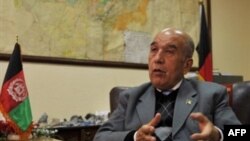KABUL -- An Afghan government official has rejected suggestions in "The Washington Post" that he accepted millions of dollars from Beijing in exchange for awarding a Chinese company a lucrative copper-mining contract, RFE/RL's Radio Free Afghanistan reports.
Mining Minister Mohammad Ibrahim Adel denied any wrongdoing and insisted that the tender that gave the multibillion-dollar project to the state-run China Metallurgical Group in 2007 was transparent and approved by many different people.
An article in the November 18 edition of "The Washington Post" quoted unnamed U.S. officials as claiming that Adel accepted at least $20 million from China in awarding the project.
The Chinese firm is expected to invest some $3 billion and pay the Afghan government about $400 million per year in royalties to mine one of the world's largest copper deposits.
It appears to be the largest-ever FDI venture in Afghanistan.
Adel told RFE/RL that the contract was not accepted "by one or two people" but was "approved by a group of 20 people including six parliamentarians."
He said the Chinese company was ranked high by the 20-member team and their findings were scrutinized by a six-member cabinet committee before being approved by Afghan President Hamid Karzai.
Adel added that he can present documentation that proves the process was transparent.
He suggested that "The Washington Post" report is part of a six-month old propaganda campaign against Karzai's government, saying "wherever there is good work going on or there are bright spots, they are attacked."
Adel told RFE/RL: "I don't have any stains. Any day, anytime, anyone can come and check our documents and then decide for themselves who is right [and who is wrong]."
China has substantially increased investments in Central and South Asia, as well as Africa and other places, on the strength of decades of economic growth and massive export-driven revenues.
Mining Minister Mohammad Ibrahim Adel denied any wrongdoing and insisted that the tender that gave the multibillion-dollar project to the state-run China Metallurgical Group in 2007 was transparent and approved by many different people.
An article in the November 18 edition of "The Washington Post" quoted unnamed U.S. officials as claiming that Adel accepted at least $20 million from China in awarding the project.
The Chinese firm is expected to invest some $3 billion and pay the Afghan government about $400 million per year in royalties to mine one of the world's largest copper deposits.
It appears to be the largest-ever FDI venture in Afghanistan.
Adel told RFE/RL that the contract was not accepted "by one or two people" but was "approved by a group of 20 people including six parliamentarians."
He said the Chinese company was ranked high by the 20-member team and their findings were scrutinized by a six-member cabinet committee before being approved by Afghan President Hamid Karzai.
Adel added that he can present documentation that proves the process was transparent.
He suggested that "The Washington Post" report is part of a six-month old propaganda campaign against Karzai's government, saying "wherever there is good work going on or there are bright spots, they are attacked."
Adel told RFE/RL: "I don't have any stains. Any day, anytime, anyone can come and check our documents and then decide for themselves who is right [and who is wrong]."
China has substantially increased investments in Central and South Asia, as well as Africa and other places, on the strength of decades of economic growth and massive export-driven revenues.







